Photovoltaic/Hydrokinetic/Hydrogen Energy System Sizing Considering Uncertainty: A Stochastic Approach Using Two-Point Estimate Method and Improved Gradient-Based Optimizer
Abstract
:1. Introduction
1.1. Motivation and Background
1.2. Literature Review and Research Gaps
- Battery storage, in particular, was used in the majority of research [22,23,24,25,26,27,28,29,30,31,32,33,34,35,36,37,38,39,40,41] on the size of HRESs made up of solar and wind sources to fulfill the demand. Hydrokinetic (HKT) energy systems have recently been considered in order to improve the effectiveness of power generation sources. As a result, the inclusion of HKT resources in the HRES may improve energy efficiency.
- The majority of hybrid energy system sizing studies, such those in [22,23,24,25,26,27,28,29,30,31,32,33,34,35,36,37,38,39,40], have not taken modeling uncertainty into account when determining system sizes. Keep in mind that the RES’s capacity and production are unclear. Therefore, in one scenario, the amount of load or renewable generation could be more or less than what the deterministic model predicted. The results from the stochastic sizing are less reliable than those from the deterministic model in this example because the quantity of batteries selected in the deterministic model could not be sufficient to account for the variations in load demand and renewable resource generation.
- Due to the enormous number of scenarios it takes into account, the Monte Carlo simulation (MCS) method, one of the standard approaches to uncertainty modeling, has a very high computational cost and necessitates the employment of scenarios reduction techniques. Additionally, the probability distribution function (PDF) of its inputs has a significant impact on the outcome.
- One of the most crucial elements in finding the best solution for the sizing of HRESs is the employment of robust and highly accurate optimization algorithms. According to the literature, in a small number of studies, the effectiveness of these algorithms is improved to avoid premature convergence, the risk that these methods may become stuck solving challenging problems at the local optimal level, and the possibility that increasing their efficiency may lead to rapid convergence to the optimal solution with low tolerance.
1.3. Contributions
- Stochastic sizing of a stand-alone hybrid photovoltaic/hydrokinetic/fuel cell energy system (hPV/HKT/FC) integrated with hydrogen storage is carried out in this study with the goal of minimizing the cost of project life span (COPL) and the reliability index as the probability of load shortage (POLS), while taking into account the unpredictability of renewable resource generation and system demand.
- In order to properly express and analyze uncertainties, the 2m+1 PEM [43,44] is used to describe the uncertainties of RES generation and system load demand. The 2m+1 PEM does not rely on the PDF of unknown variables, in contrast to the MCS. Instead, it makes use of the original statistical moments to solve the approximations’ inadequacies. Additionally, it shows a lower computing burden and quicker iteration convergence as compared to the MCS. The simulation results are shown for three hPV/HKT/FC, hPV/FC, and hHKT/FC configurations of the HRES in two situations of deterministic and stochastic sizing, with and without taking uncertainty into account.
- The GBO [45] is a meta-heuristic algorithm for solving mathematical problems that draws its inspiration from Newton’s method and is enhanced by a dynamic lens-imaging learning method to avoid premature convergence. The IGBO is used to determine the decision variables, such as the HRES components’ ideal capacity.
1.4. Paper Structure
2. The Studied HRES
2.1. Configurations
2.2. The HRES Modelling
2.2.1. PV
2.2.2. HKT
2.2.3. EL
2.2.4. HST
2.2.5. FC
2.2.6. Inverter
3. Stochastic Approach
- Step (1)
- Define the quantity of the RIV (m).
- Step (2)
- Specify the moment vector of the output variable as . Here, signifies the moment vector of the output variable at the ith position.
- Step (3)
- Tuning .
- Step (4)
- The 2 standard positions of the variable randomly are acquired in the following manner:
- Step (5)
- The positions are delineated as follows:
- Step (6)
- The deterministic sizing of the HRES is implemented for two locations.
- Step (7)
- Two weighting factors () for are established:
- Step (8)
- Update .
- Step (9)
- Repeat Steps 4 to 8 for each subsequent iteration of the variable, until all RIVs have been taken into consideration.
- Step (10)
- The hPV/HKT/FC deterministic sizing problem is executed based on the RIV vector provided by
- Step (11)
- The weight coefficient for the HRES sizing, which was solved in Step (10), is computed using the following formula.
- Step (12)
- is outlined as follows.
- Step (13)
- According to the statistical moments related to the output random variable (ROV), the mean value and standard deviation are established as follows.
4. Problem Formulation
4.1. Objective Function
4.2. Constraint
4.2.1. Reliability Constraint
4.2.2. Components Constraint
5. Proposed Optimizer
5.1. GBO
5.1.1. Gradient Search Rule (GSR)
5.1.2. Enhancing Efficiency with Local Escape Operator (LEO)
5.2. IGBO Based on the Dynamic Lens-Imaging Learning
5.3. IGBO Implementation
- Step (1)
- Initializing the data for an HRES, which include information on wind, irradiance, and load demand for a year, as well as numerical data pertaining to the size, cost, efficiency, and lifetime of the system’s components.
- Step (2)
- Commence the algorithm population, establish the maximum iteration, and determine the repetition. Additionally, the variables are generated randomly.
- Step (3)
- The COPL (Equation (16)) is computed for each algorithm’s member. This computation is performed on variables that have been randomly assigned while ensuring that they satisfy the POLS (Equation (20)).
- Step (4)
- Identification of the most optimal individual within the algorithm population is conducted by evaluating the individual’s COPL value, with preference given to those with lower COPL values, as well as considering their POLS performance, aiming for improved outcomes.
- Step (5)
- Proceed with the revision of the algorithm population.
- Step (6)
- The COPL meeting POLS is computed for members of the population identified in Step (5).
- Step (7)
- Identification of the optimal variable set characterized by the minimal COPL and superior POLS if the current COPL is less than the COPL calculated in Step (4), the current set is replaced with the latter.
- Step (8)
- Convergence metrics are evaluated. If these metrics meet the required criteria, we proceed to Step (10). However, if the convergence indices do not meet the required criteria, we must go to Step (5).
- Step (9)
- Set of variables that yield the ideal outcome is found.
- Step (10)
- Terminate the implementation of the algorithm.
6. Simulation Results and Discussion
6.1. System Data
6.2. Results of Deterministic Sizing
6.3. Results of Stochastic Sizing
6.4. Deterministic and Stochastic Results Comparison
6.5. Comparison with Previous Studies
6.6. Discussion
7. Conclusions
- The deterministic results cleared that the hPV/HKT/FC configuration was the optimal with lowest COPL and POLS (highest reliability level) and the hPV/FC configuration obtained higher COPL and POLS. COPL and POLS achieved 0.0339 and 2.056 M$, for the hPV/HKT/FC configuration and for hPV/FC configuration they obtained 0.0401 and 2.131 M$, respectively.
- The findings proved the superior sizing capability of the IGBO compared with conventional GBO, PSO, and GWO methods with the lowest COPL and POLS. The results of the comparison of the algorithms confirmed the capability of the dynamic lens-imaging learning technique to improve the conventional GBO performance in achieving the best solution with less convergence tolerance.
- The stochastic sizing results showed that the hPV/HKT/FC configuration was obtained as the optimal configuration for the lowest obtained COPL and POLS compared with other configurations; moreover, the hPV/FC was introduced as an expensive configuration. The COPL and POLS for optimal configuration were obtained at 0.0322 and 2.213 M$ and were also achieved at 0.0383 and 5.327 M$, respectively, for expensive configuration.
- Therefore, the results demonstrated that the storage level obtained in deterministic sizing does not guarantee the load requirement in the conditions of uncertainty that the proposed stochastic sizing increased the renewable production level and also hydrogen storage level to more accurately support the load needs. In other words, stochastic sizing, taking into account uncertainties, can lead to correct scheduling and optimal load demand support with the correct knowledge of values of cost and reliability.
- The robust sizing and energy management of the hPV/HKT/FC energy system with multi-energy storage using the information gap decision theory is suggested for future work. In other words, in this proposed plan, the effect of using the robust method compared to the stochastic method will be investigated in terms of uncertainty on the sizing problem considering battery and hydrogen-based energy storage.
- Additionally, the stochastic sizing of the hPV/HKT energy system integrated with different technologies of battery energy storage is suggested for future work. In this project, the effect of various battery technologies, including lithium-ion and Vanadium redox batteries, on solving the sizing problem under conditions of uncertainty will be evaluated.
Author Contributions
Funding
Institutional Review Board Statement
Informed Consent Statement
Data Availability Statement
Conflicts of Interest
Nomenclature
| AEFA | Artificial Electric Field Algorithm |
| CM | Central Moment |
| COE | Cost of Energy |
| COPL | Cost of Project Life Span |
| DLIL | Dynamic Lens-imaging Learning |
| DM | Direct Motion |
| EL | Electrolyzer |
| FA | Firefly Algorithm |
| FC | Fuel Cell |
| FPA | Flower Pollination Algorithm |
| GA | Genetic Algorithm |
| GBO | Gradient Based-Optimizer |
| GSR | Gradient Search Rule |
| HKT | Hydrokinetic |
| HRES | Hybrid Renewable Energy System |
| HSA | Harmony Search Algorithm |
| HST | Hydrogen Storage Tank |
| IAEO | Artificial Ecosystem-based Optimization Algorithm |
| IEBA | Improved Equilibrium Optimization Algorithm |
| IGBO | Improved Gradient Based-Optimizer |
| IGOA | Improved Grasshopper Optimization Algorithm |
| ISCA | Improved Sine–Cosine Algorithm |
| ISHO | Improved Spotted Hyena Optimizer |
| LEO | Local Escape Operator |
| LPSP | Loss of Power Supply Probability |
| MCS | Monte Carlo Simulation |
| PEM | Point Estimate Method |
| Probability Distribution Function | |
| POLS | Probability of Load Shortage |
| PSO | Particle Swarm Optimization |
| PV | Photovoltaic |
| RIV | Random Input Variable |
| SSO | Salp Swarm Optimization |
| WOA | Whale Optimization Algorithm |
References
- Sarker, A.K.; Azad, A.K.; Rasul, M.G.; Doppalapudi, A.T. Prospect of Green Hydrogen Generation from Hybrid Renewable Energy Sources: A Review. Energies 2023, 16, 1556. [Google Scholar] [CrossRef]
- Huang, S.; Huang, M.; Lyu, Y. Seismic performance analysis of a wind turbine with a monopile foundation affected by sea ice based on a simple numerical method. Eng. Appl. Comput. Fluid Mech. 2021, 15, 1113–1133. [Google Scholar] [CrossRef]
- Zhang, Z.; Altalbawy, F.M.; Al-Bahrani, M.; Riadi, Y. Regret-based multi-objective optimization of carbon capture facility in CHP-based microgrid with carbon dioxide cycling. J. Clean. Prod. 2023, 384, 135632. [Google Scholar] [CrossRef]
- Mahzouni-Sani, M.; Hamidi, A.; Nazarpour, D.; Golshannavaz, S. Multi-objective linearised optimal reactive power dispatch of wind-integrated transmission networks. IET Gener. Transm. Distrib. 2019, 13, 2686–2696. [Google Scholar] [CrossRef]
- Baghban-Novin, S.; Mahzouni-Sani, M.; Hamidi, A.; Golshannavaz, S.; Nazarpour, D.; Siano, P. Investigating the impacts of feeder reforming and distributed generation on reactive power demand of distribution networks. Sustain. Energy Grids Netw. 2020, 22, 100350. [Google Scholar] [CrossRef]
- Fathi, R.; Tousi, B.; Galvani, S. A new approach for optimal allocation of photovoltaic and wind clean energy resources in distribution networks with reconfiguration considering uncertainty based on info-gap decision theory with risk aversion strategy. J. Clean. Prod. 2021, 295, 125984. [Google Scholar] [CrossRef]
- Rostami, A.; Mohammadi, M.; Karimipour, H. Reliability assessment of cyber-physical power systems considering the impact of predicted cyber vulnerabilities. Int. J. Electr. Power Energy Syst. 2023, 147, 108892. [Google Scholar] [CrossRef]
- Liu, Z.; Tang, P.; Hou, K.; Zhu, L.; Zhao, J.; Jia, H.; Pei, W. A Lagrange-multiplier-based Reliability Assessment for Power Systems Considering Topology and Injection Uncertainties. IEEE Trans. Power Syst. 2023, 1–11. [Google Scholar] [CrossRef]
- Crooks, J.M.; Hewlin, R.L., Jr.; Williams, W.B. Computational Design Analysis of a Hydrokinetic Hori-zontal Parallel Stream Direct Drive Counter-Rotating Darrieus Turbine System: A Phase One Design Analysis Study. Energies 2022, 15, 8942. [Google Scholar] [CrossRef]
- Kirke, B. Hydrokinetic turbines for moderate sized rivers. Energy Sustain. Dev. 2020, 58, 182–195. [Google Scholar] [CrossRef] [PubMed]
- Saini, G.; Saini, R.P. Clearance and blockage effects on hydrodynamic performance of hybrid hydrokinetic turbine. Sustain. Energy Technol. Assess. 2023, 57, 103210. [Google Scholar] [CrossRef]
- Li, M.; Yang, M.; Yu, Y.; Lee, W.J. A wind speed correction method based on modified hidden Markov model for enhancing wind power forecast. IEEE Trans. Ind. Appl. 2021, 58, 656–666. [Google Scholar] [CrossRef]
- Chen, H.; Wu, H.; Kan, T.; Zhang, J.; Li, H. Low-carbon economic dispatch of integrated energy system containing electric hydrogen production based on VMD-GRU short-term wind power prediction. Int. J. Electr. Power Energy Syst. 2023, 154, 109420. [Google Scholar] [CrossRef]
- Zhang, L.; Sun, C.; Cai, G.; Koh, L.H. Charging and discharging optimization strategy for electric vehicles considering elasticity demand response. eTransportation 2023, 18, 100262. [Google Scholar] [CrossRef]
- Alanazi, M.; Alanazi, A.; Almadhor, A.; Rauf, H.T. An Improved Fick’s Law Algorithm Based on Dynamic Lens-Imaging Learning Strategy for Planning a Hybrid Wind/Battery Energy System in Distribution Network. Mathematics 2023, 11, 1270. [Google Scholar] [CrossRef]
- Shezan, S.A.; Kamwa, I.; Ishraque, M.F.; Muyeen, S.M.; Hasan, K.N.; Saidur, R.; Rizvi, S.M.; Shafiullah, M.; Al-Sulaiman, F.A. Evaluation of different optimization techniques and control strategies of hybrid microgrid: A review. Energies 2023, 16, 1792. [Google Scholar] [CrossRef]
- Aschidamini, G.L.; da Cruz, G.A.; Resener, M.; Ramos, M.J.; Pereira, L.A.; Ferraz, B.P.; Haffner, S.; Pardalos, P.M. Expansion Planning of Power Distribution Systems Considering Reliability: A Comprehensive Review. Energies 2022, 15, 2275. [Google Scholar] [CrossRef]
- Kiehbadroudinezhad, M.; Merabet, A.; Hosseinzadeh-Bandbafha, H. Review of latest advances and prospects of energy storage systems: Considering economic, reliability, sizing, and environmental impacts approach. Clean Technol. 2022, 4, 477–501. [Google Scholar] [CrossRef]
- Cai, T.; Dong, M.; Chen, K.; Gong, T. Methods of participating power spot market bidding and settlement for renewable energy systems. Energy Rep. 2022, 8, 7764–7772. [Google Scholar] [CrossRef]
- Liu, Z.; Li, H.; Hou, K.; Xu, X.; Jia, H.; Zhu, L.; Mu, Y. Risk assessment and alleviation of regional integrated energy system considering cross-system failures. Appl. Energy 2023, 350, 121714. [Google Scholar] [CrossRef]
- Jiang, J.; Zhang, L.; Wen, X.; Valipour, E.; Nojavan, S. Risk-based performance of power-to-gas storage technology integrated with energy hub system regarding downside risk constrained approach. Int. J. Hydrogen Energy 2022, 47, 39429–39442. [Google Scholar] [CrossRef]
- Menesy, A.S.; Sultan, H.M.; Habiballah, I.O.; Masrur, H.; Khan, K.R.; Khalid, M. Optimal Configuration of a Hybrid Photovoltaic/Wind Turbine/Biomass/Hydro-Pumped Storage-Based Energy System Using a Heap-Based Optimization Algorithm. Energies 2023, 16, 3648. [Google Scholar] [CrossRef]
- Jin, H.; Yang, X. Bilevel Optimal Sizing and Operation Method of Fuel Cell/Battery Hybrid All-Electric Shipboard Microgrid. Mathematics 2023, 11, 2728. [Google Scholar] [CrossRef]
- Ghoniem, R.M.; Alahmer, A.; Rezk, H.; As’ad, S. Optimal Design and Sizing of Hybrid Photovoltaic/Fuel Cell Electrical Power System. Sustainability 2023, 15, 12026. [Google Scholar] [CrossRef]
- Mohammed, A. An Optimization-Based Model for A Hybrid Photovoltaic-Hydrogen Storage System for Agricultural Operations in Saudi Arabia. Processes 2023, 11, 1371. [Google Scholar] [CrossRef]
- Sanajaoba, S. Optimal sizing of off-grid hybrid energy system based on minimum cost of energy and reliability criteria using firefly algorithm. Sol. Energy 2019, 188, 655–666. [Google Scholar] [CrossRef]
- Pires, A.L.G.; Junior, P.R.; Rocha, L.C.S.; Peruchi, R.S.; Janda, K.; de Carvalho Miranda, R. Environmental and financial multi-objective optimization: Hybrid wind-photovoltaic generation with battery energy storage systems. J. Energy Storage 2023, 66, 107425. [Google Scholar] [CrossRef]
- Naderipour, A.; Nowdeh, S.A.; Saftjani, P.B.; Abdul-Malek, Z.; Mustafa, M.W.B.; Kamyab, H.; Davoudkhani, I.F. Deterministic and probabilistic multi-objective placement and sizing of wind renewable energy sources using improved spotted hyena optimizer. J. Clean. Prod. 2021, 286, 124941. [Google Scholar] [CrossRef]
- Mahesh, A.; Sushnigdha, G. Optimal sizing of photovoltaic/wind/battery hybrid renewable energy system including electric vehicles using improved search space reduction algorithm. J. Energy Storage 2022, 56, 105866. [Google Scholar] [CrossRef]
- Zhang, W.; Zheng, Z.; Liu, H. Droop control method to achieve maximum power output of photovoltaic for parallel inverter system. CSEE J. Power Energy Syst. 2021, 8, 1636–1645. [Google Scholar]
- Jahannoosh, M.; Nowdeh, S.A. Optimal designing and management of a stand-alone hybrid energy system using meta-heuristic improved sine-cosine algorithm for Recreational Center, case study for Iran country. Appl. Soft Comput. 2020, 96, 106611. [Google Scholar] [CrossRef]
- Niveditha, N.; Singaravel, M.R. Optimal sizing of hybrid PV–Wind–Battery storage system for Net Zero Energy Buildings to reduce grid burden. Appl. Energy 2022, 324, 119713. [Google Scholar] [CrossRef]
- Maleki, A.; Nazari, M.A.; Pourfayaz, F. Harmony search optimization for optimum sizing of hybrid solar schemes based on battery storage unit. Energy Rep. 2020, 6, 102–111. [Google Scholar] [CrossRef]
- Ridha, H.M.; Gomes, C.; Hizam, H.; Mirjalili, S. Multiple scenarios multi-objective salp swarm optimization for sizing of standalone photovoltaic system. Renew. Energy 2020, 153, 1330–1345. [Google Scholar] [CrossRef]
- Naderipour, A.; Kamyab, H.; Klemeš, J.J.; Ebrahimi, R.; Chelliapan, S.; Nowdeh, S.A.; Abdullah, A.; Marzbali, M.H. Optimal design of hybrid grid-connected photovoltaic/wind/battery sustainable energy system improving reliability, cost and emission. Energy 2022, 257, 124679. [Google Scholar] [CrossRef]
- Samy, M.M.; Barakat, S.; Ramadan, H.S. A flower pollination optimization algorithm for an off-grid PV-Fuel cell hybrid renewable system. Int. J. Hydrogen Energy 2019, 44, 2141–2152. [Google Scholar] [CrossRef]
- Samy, M.M.; Mosaad, M.I.; Barakat, S. Optimal economic study of hybrid PV-wind-fuel cell system integrated to unreliable electric utility using hybrid search optimization technique. Int. J. Hydrogen Energy 2021, 46, 11217–11231. [Google Scholar] [CrossRef]
- Mokhtara, C.; Negrou, B.; Settou, N.; Settou, B.; Samy, M.M. Design optimization of off-grid Hybrid Renewable Energy Systems considering the effects of building energy performance and climate change: Case study of Algeria. Energy 2021, 219, 119605. [Google Scholar] [CrossRef]
- Gharibi, M.; Askarzadeh, A. Technical and economical bi-objective design of a grid-connected photovoltaic/diesel generator/fuel cell energy system. Sustain. Cities Soc. 2019, 50, 101575. [Google Scholar] [CrossRef]
- Yang, J.; Chen, Y.L.; Yee, P.L.; Ku, C.S.; Babanezhad, M. An Improved Artificial Ecosystem-Based Optimization Algorithm for Optimal Design of a Hybrid Photovoltaic/Fuel Cell Energy System to Supply A Residential Complex Demand: A Case Study for Kuala Lumpur. Energies 2023, 16, 2867. [Google Scholar] [CrossRef]
- Liu, Y.; Zhong, Y.; Tang, C. Sizing Optimization of a Photovoltaic Hybrid Energy Storage System Based on Long Time-Series Simulation Considering Battery Life. Appl. Sci. 2023, 13, 8693. [Google Scholar] [CrossRef]
- Naderipour, A.; Abdul-Malek, Z.; Nowdeh, S.A.; Kamyab, H.; Ramtin, A.R.; Shahrokhi, S.; Klemeš, J.J. Comparative evaluation of hybrid photovoltaic, wind, tidal and fuel cell clean system design for different regions with remote application considering cost. J. Clean. Prod. 2021, 283, 124207. [Google Scholar] [CrossRef]
- Alonso-Travesset, À.; Martín, H.; Coronas, S.; de la Hoz, J. Optimization models under uncertainty in distributed generation systems: A review. Energies 2022, 15, 1932. [Google Scholar] [CrossRef]
- Roy, N.B.; Das, D. Probabilistic optimal power dispatch in a droop controlled islanded microgrid in presence of renewable energy sources and PHEV load demand. Renew. Energy Focus 2023, 45, 93–122. [Google Scholar] [CrossRef]
- Ahmadianfar, I.; Bozorg-Haddad, O.; Chu, X. Gradient-based optimizer: A new metaheuristic optimization algorithm. Inf. Sci. 2020, 540, 131–159. [Google Scholar] [CrossRef]
- Kennedy, J.; Eberhart, R. Particle swarm optimization. In Proceedings of the ICNN’95-International Conference on Neural Networks, Perth, Australia, 27 November–1 December 1995; Volume 4, pp. 1942–1948. [Google Scholar]
- Yadav, A. AEFA: Artificial electric field algorithm for global optimization. Swarm Evol. Comput. 2019, 48, 93–108. [Google Scholar]
- Das, H.S.; Yatim, A.H.M.; Tan, C.W.; Lau, K.Y. Proposition of a PV/tidal powered micro-hydro and diesel hybrid system: A southern Bangladesh focus. Renew. Sustain. Energy Rev. 2016, 53, 1137–1148. [Google Scholar] [CrossRef]
- Long, W.; Jiao, J.; Xu, M.; Tang, M.; Wu, T.; Cai, S. Lens-imaging learning Harris hawks optimizer for global optimization and its application to feature selection. Expert Syst. Appl. 2022, 202, 117255. [Google Scholar] [CrossRef]
- Fazelpour, F.; Soltani, N.; Rosen, M.A. Economic analysis of standalone hybrid energy systems for application in Tehran, Iran. Int. J. Hydrogen Energy 2016, 41, 7732–7743. [Google Scholar] [CrossRef]
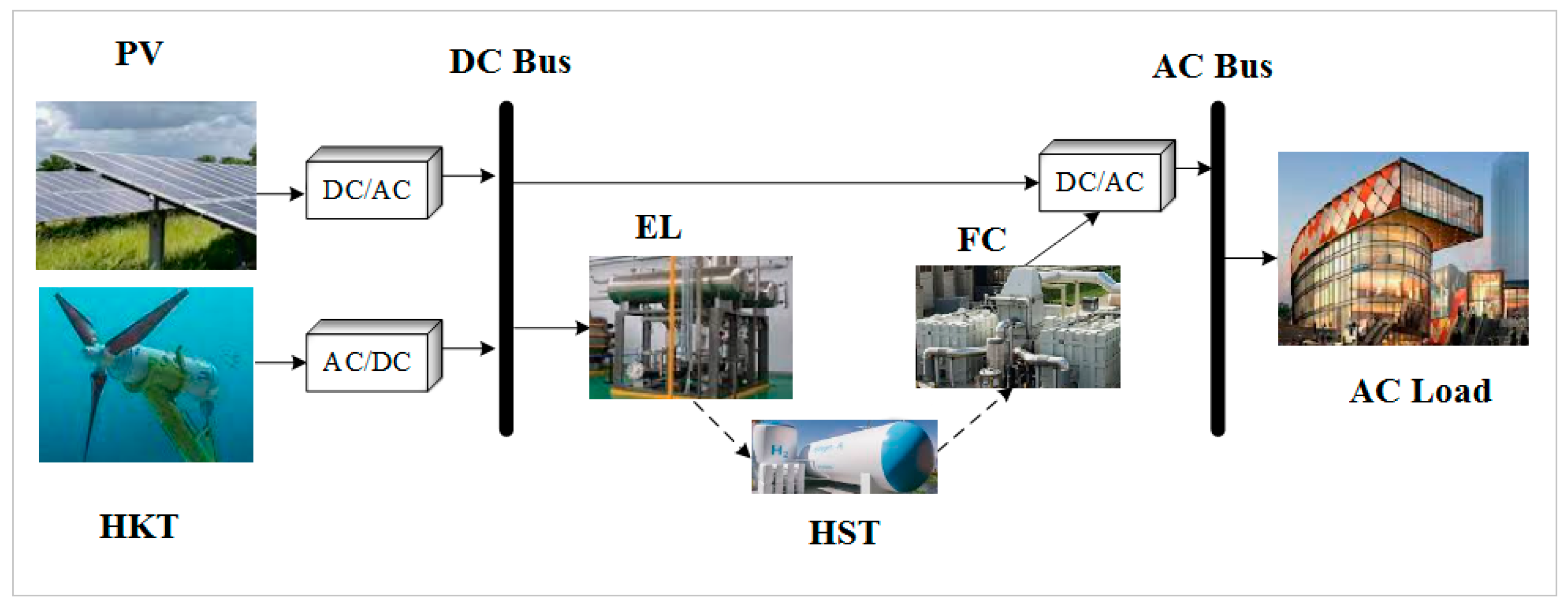
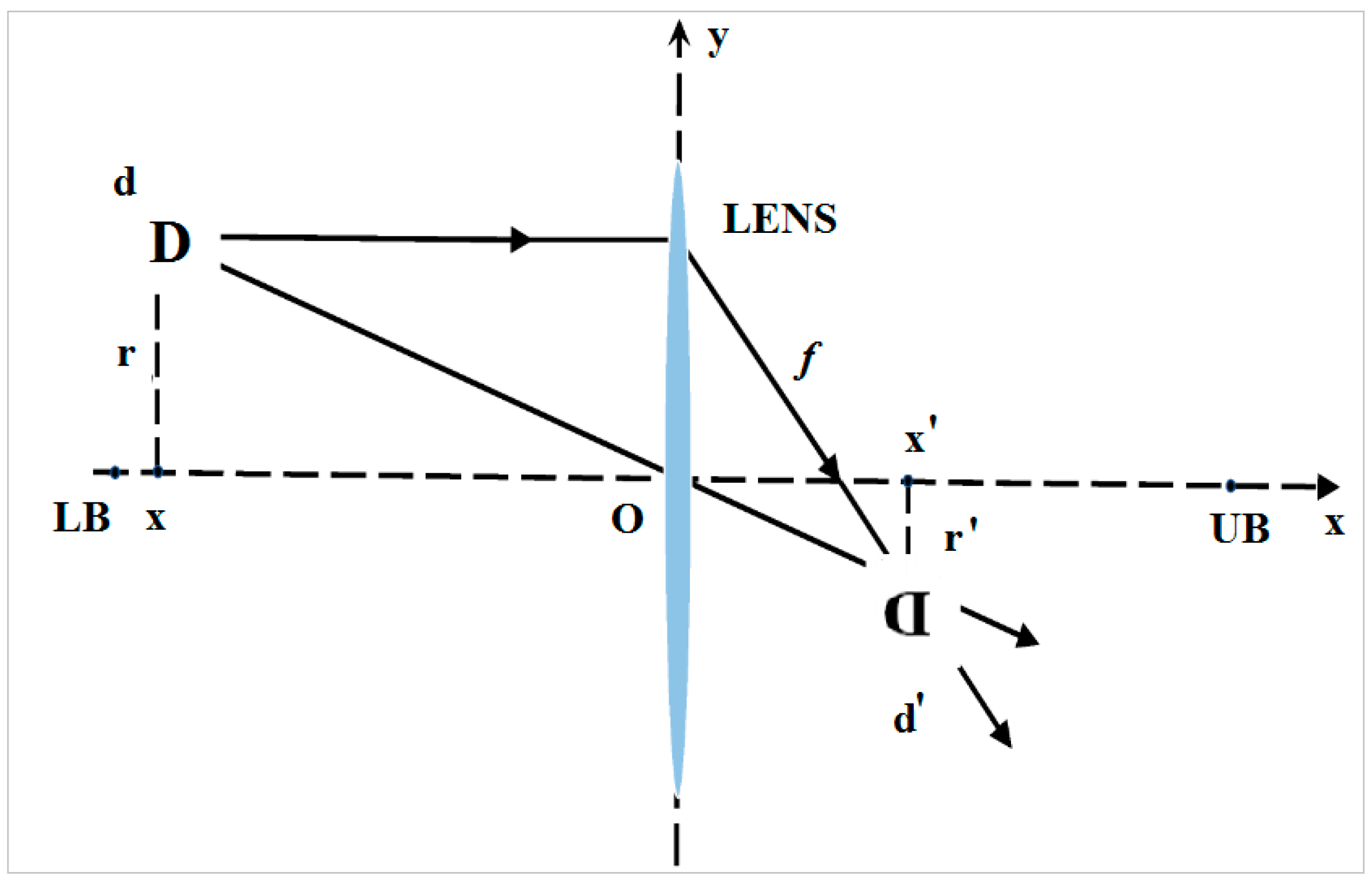



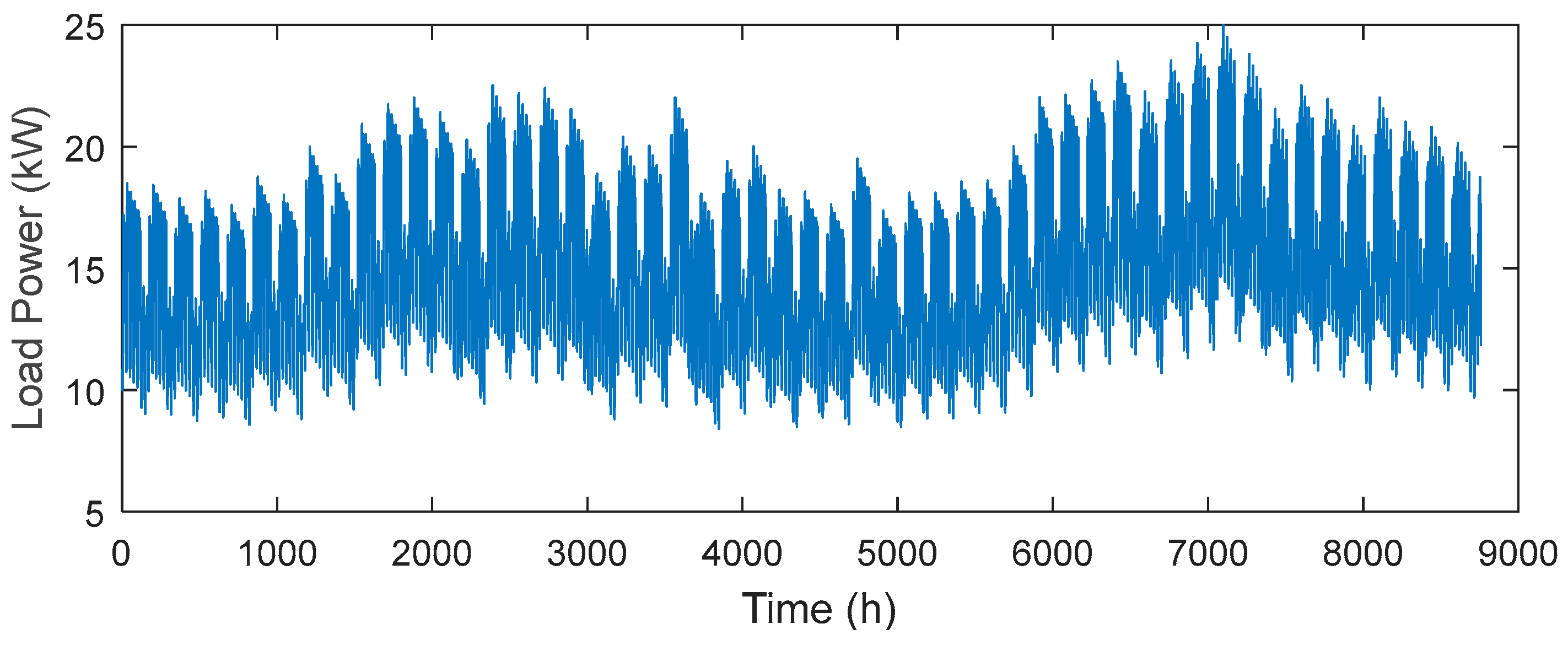
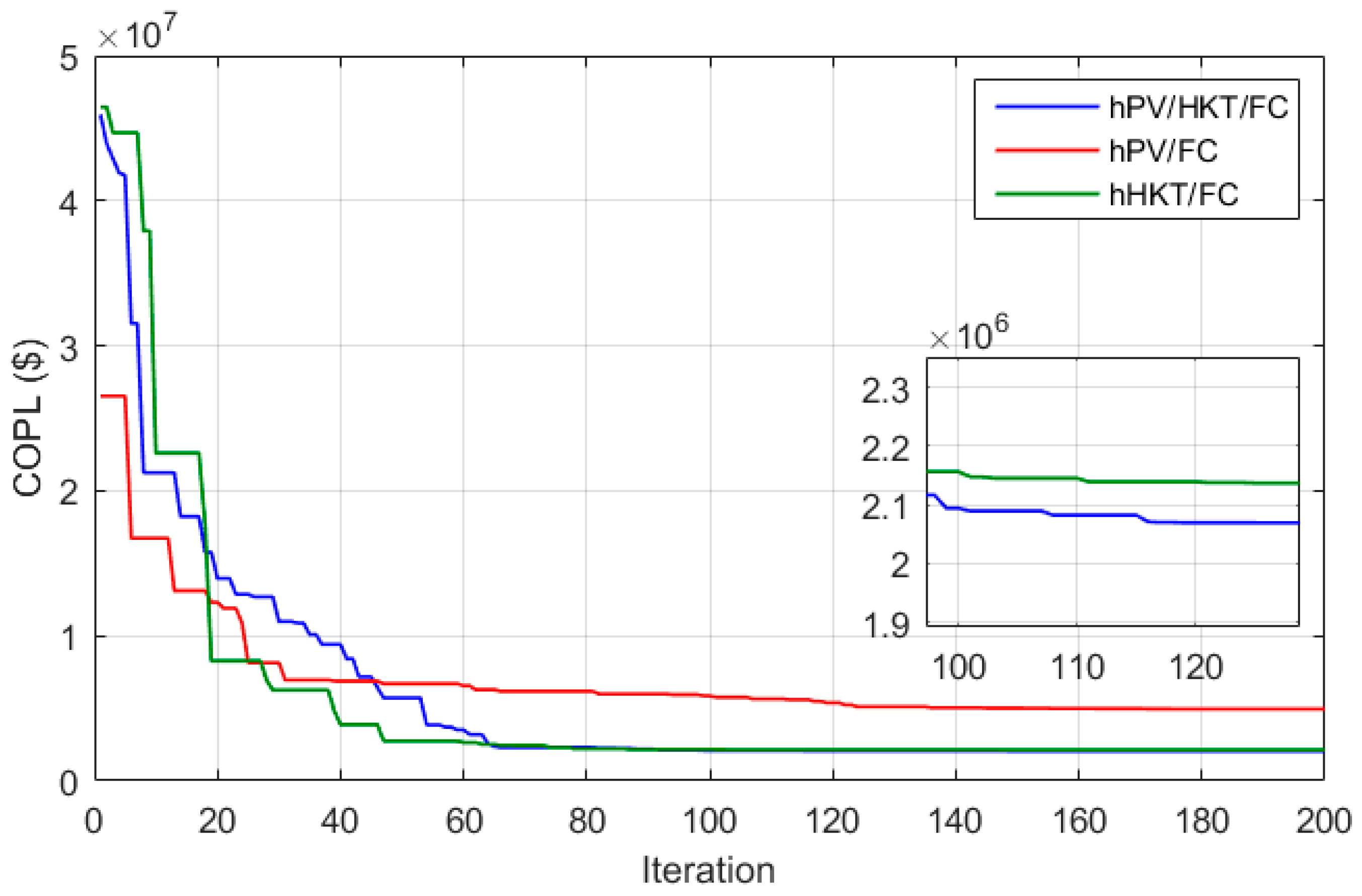
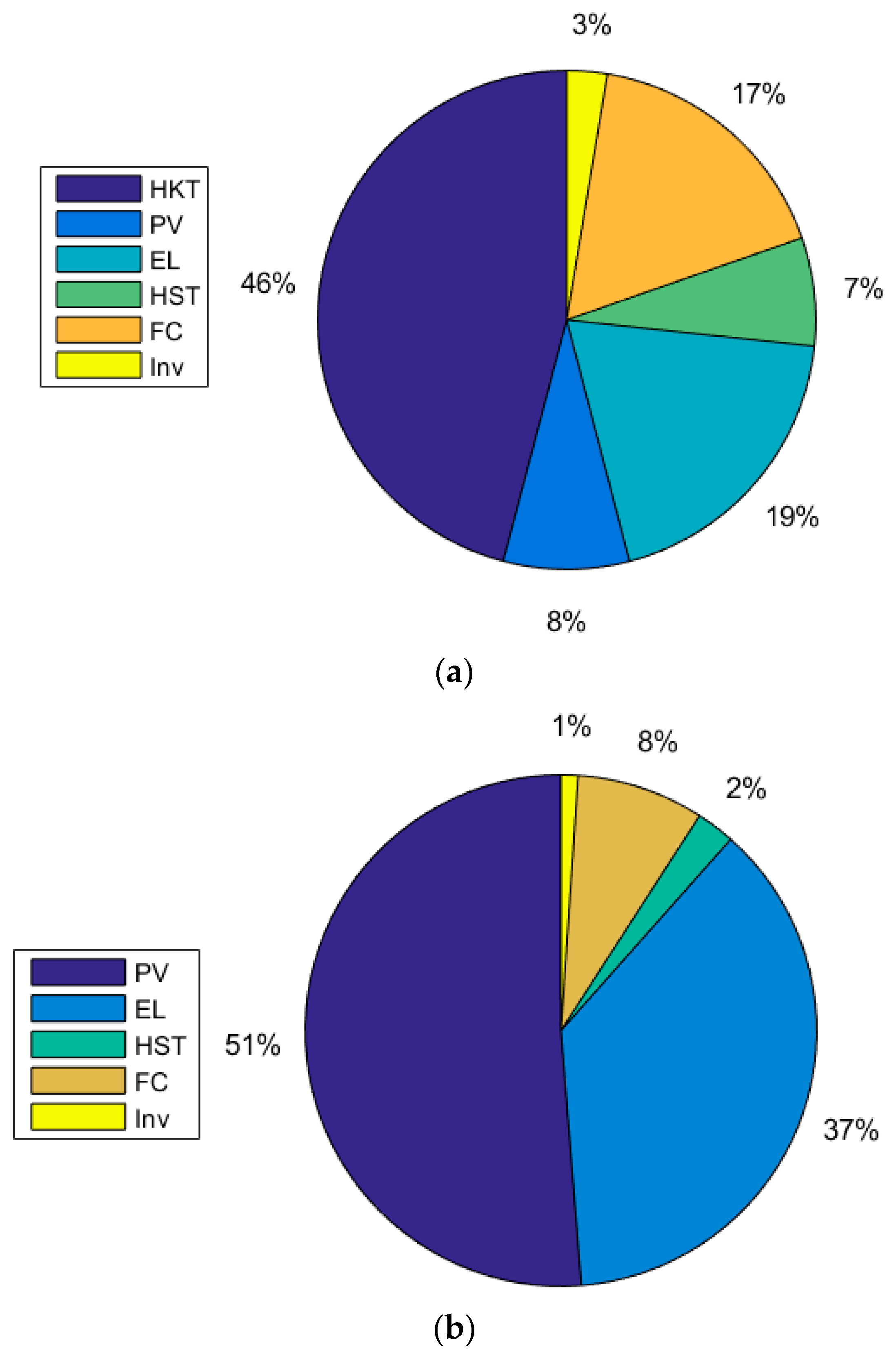
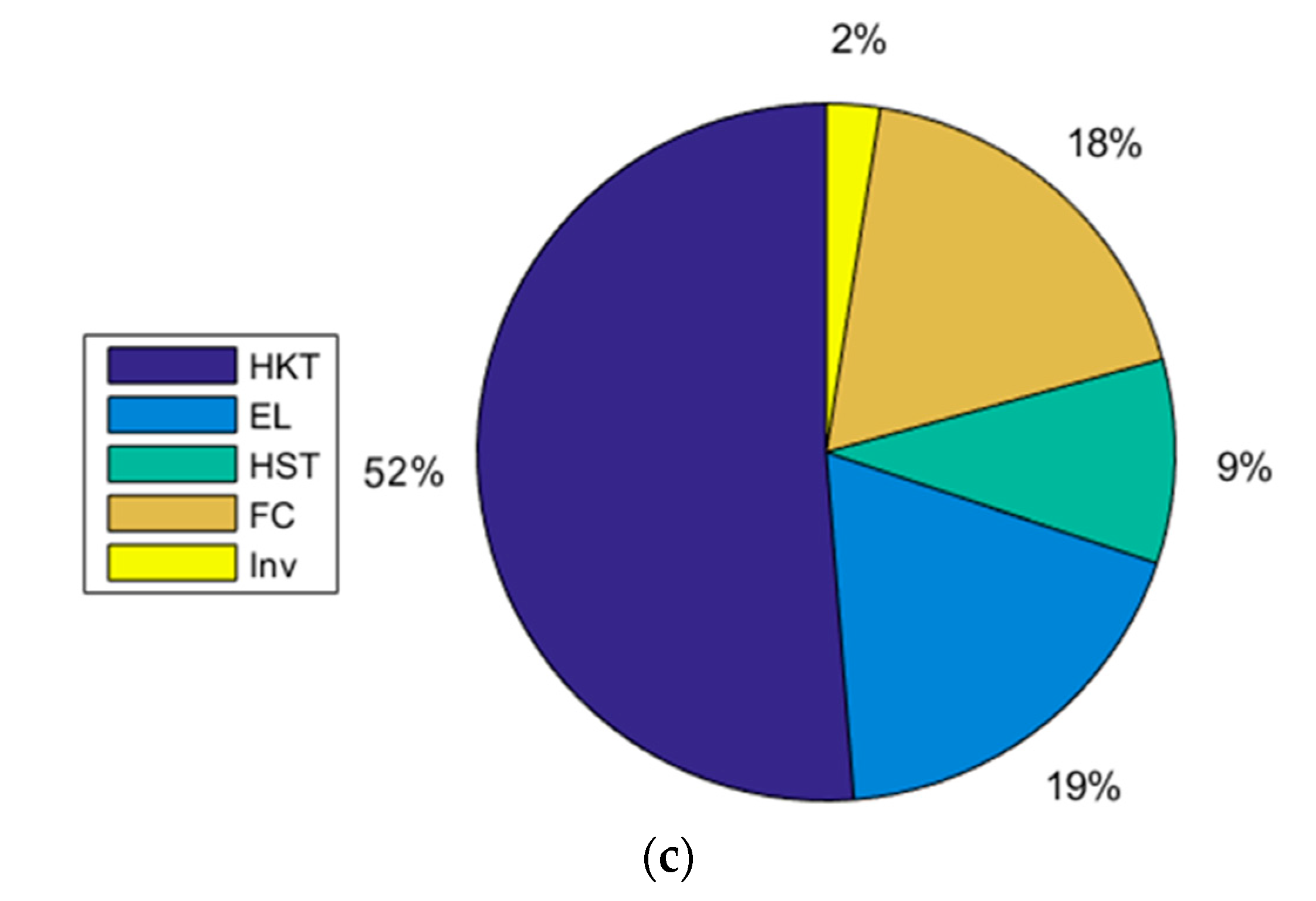
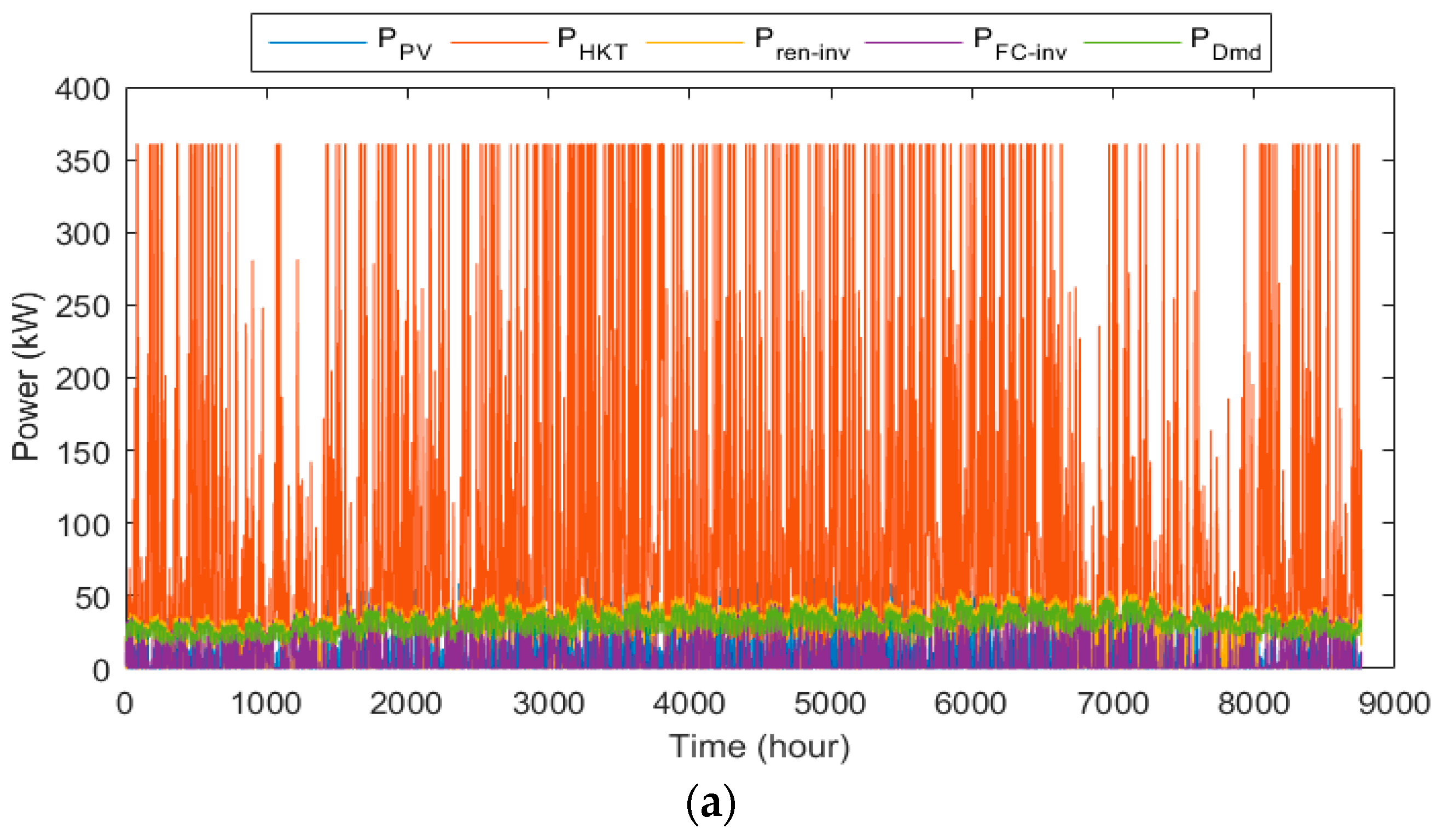
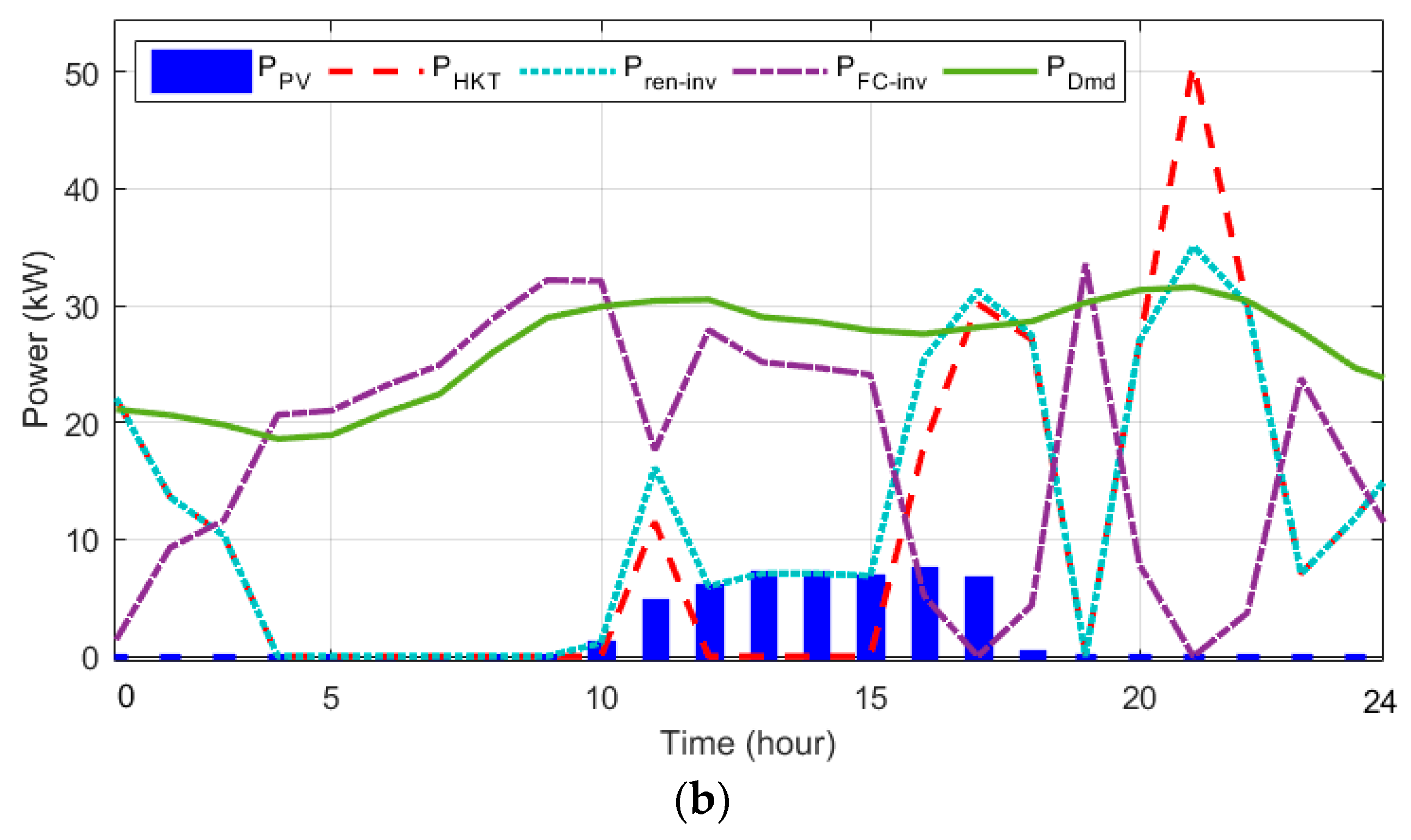

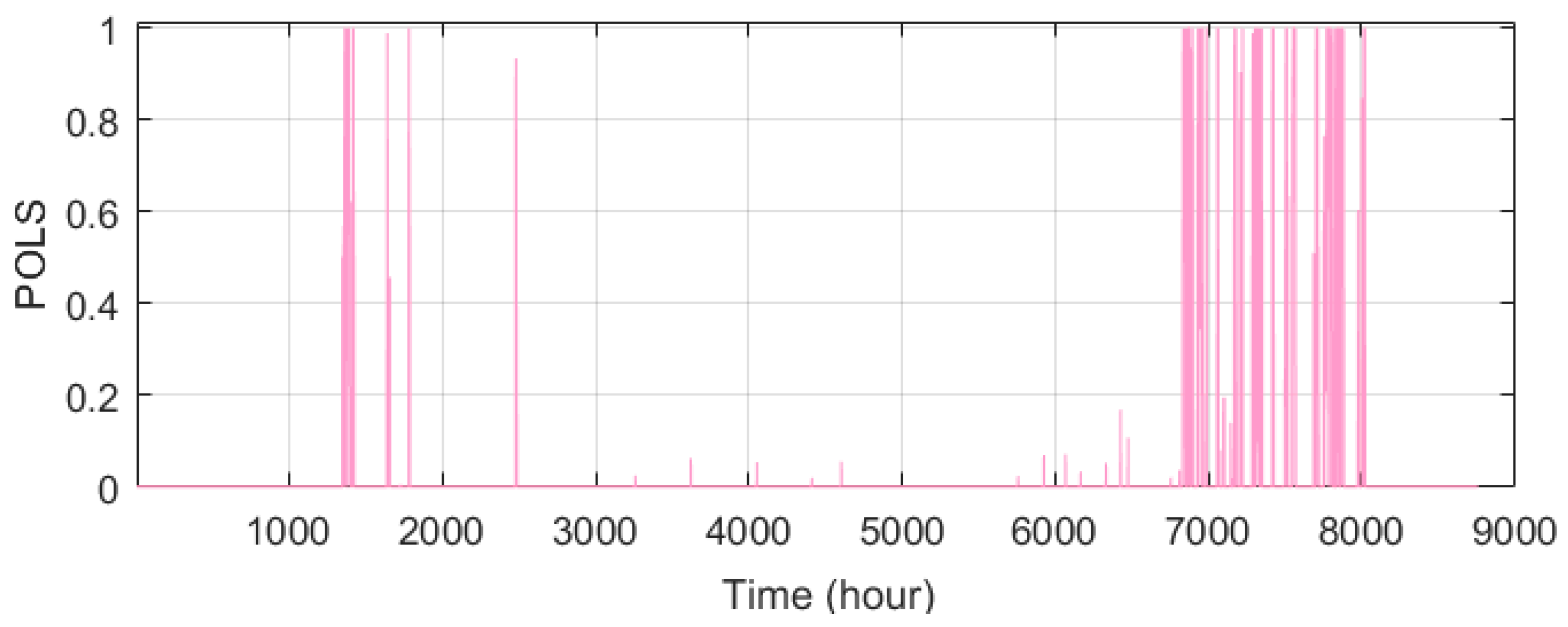

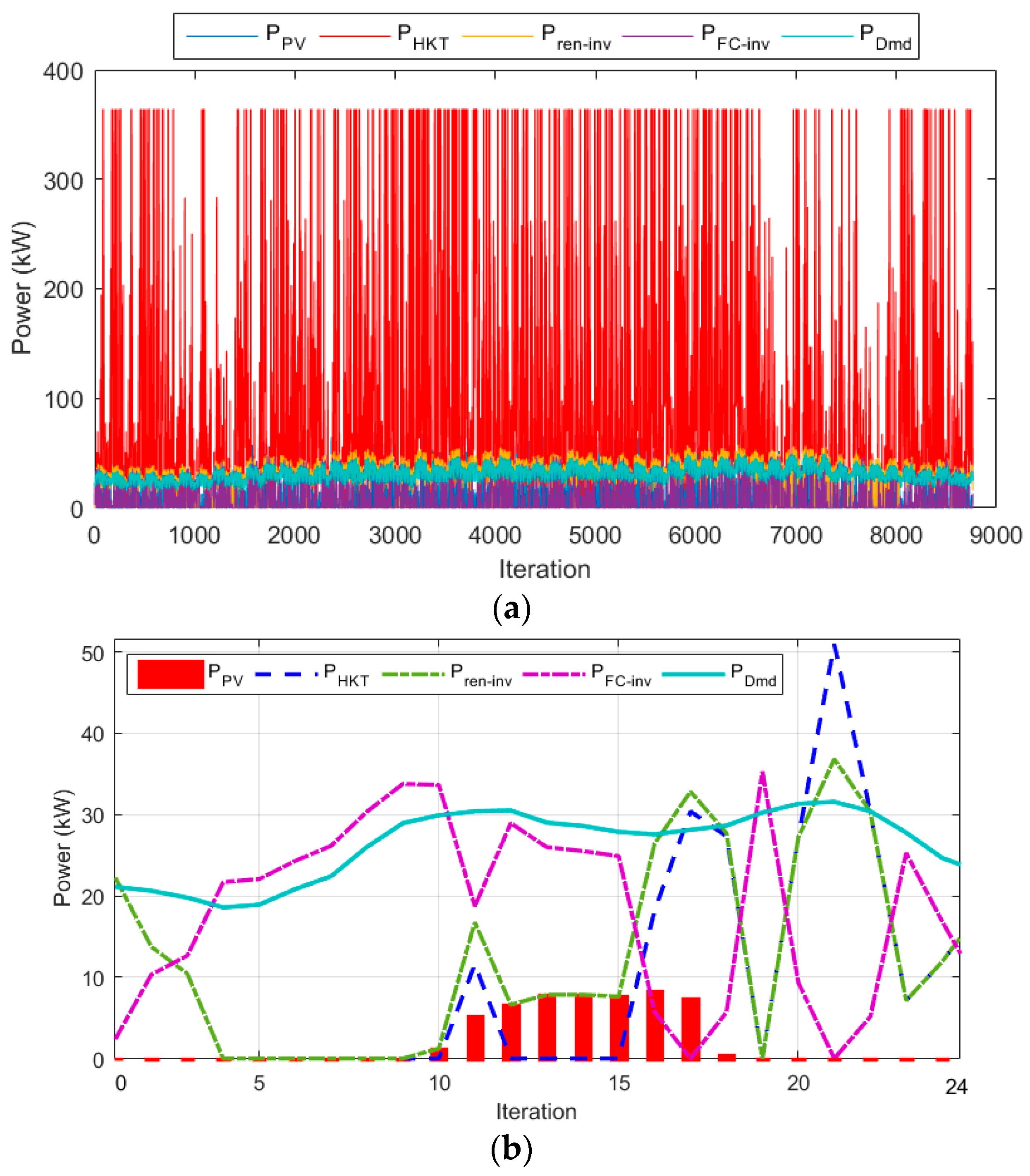
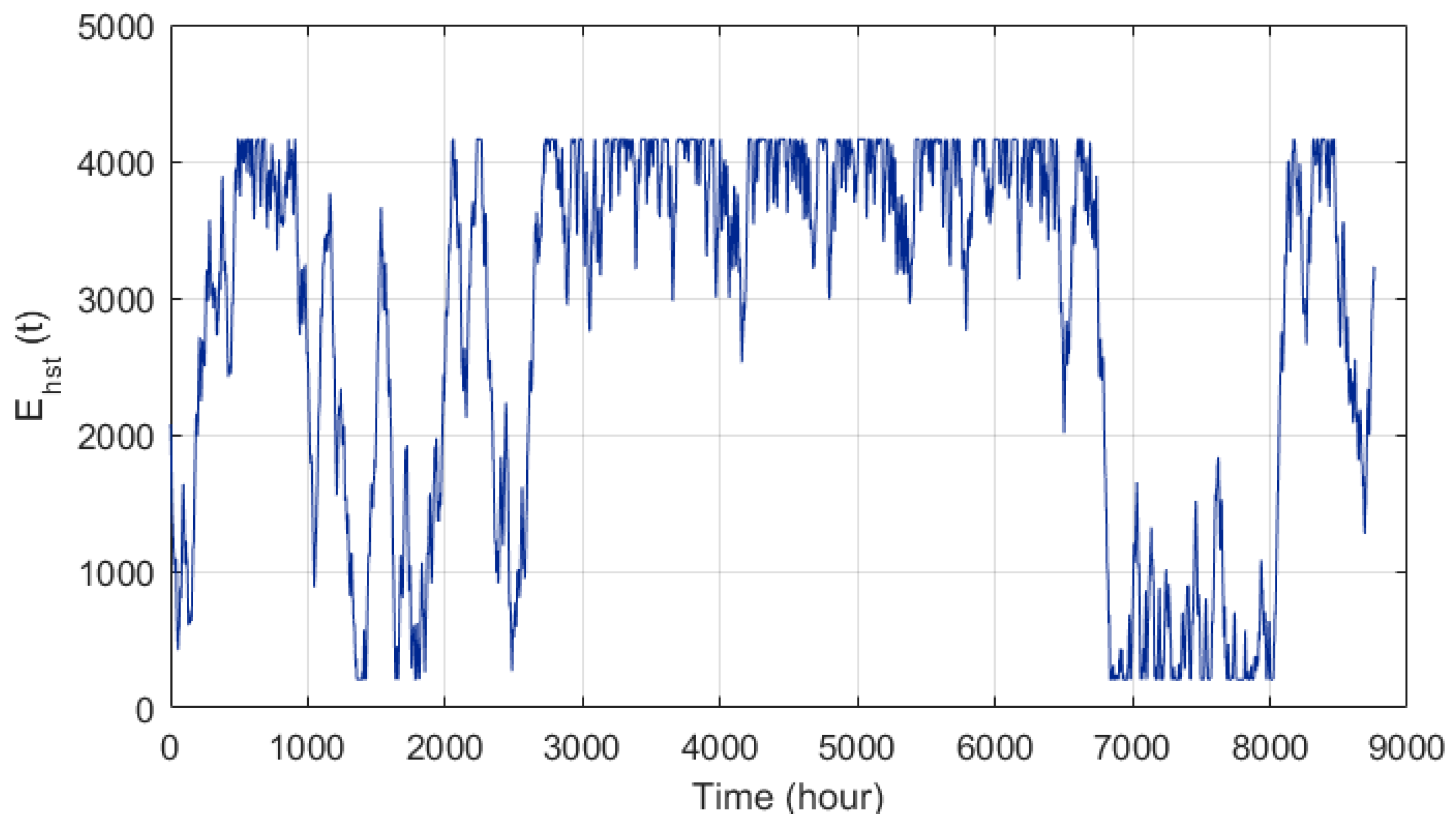
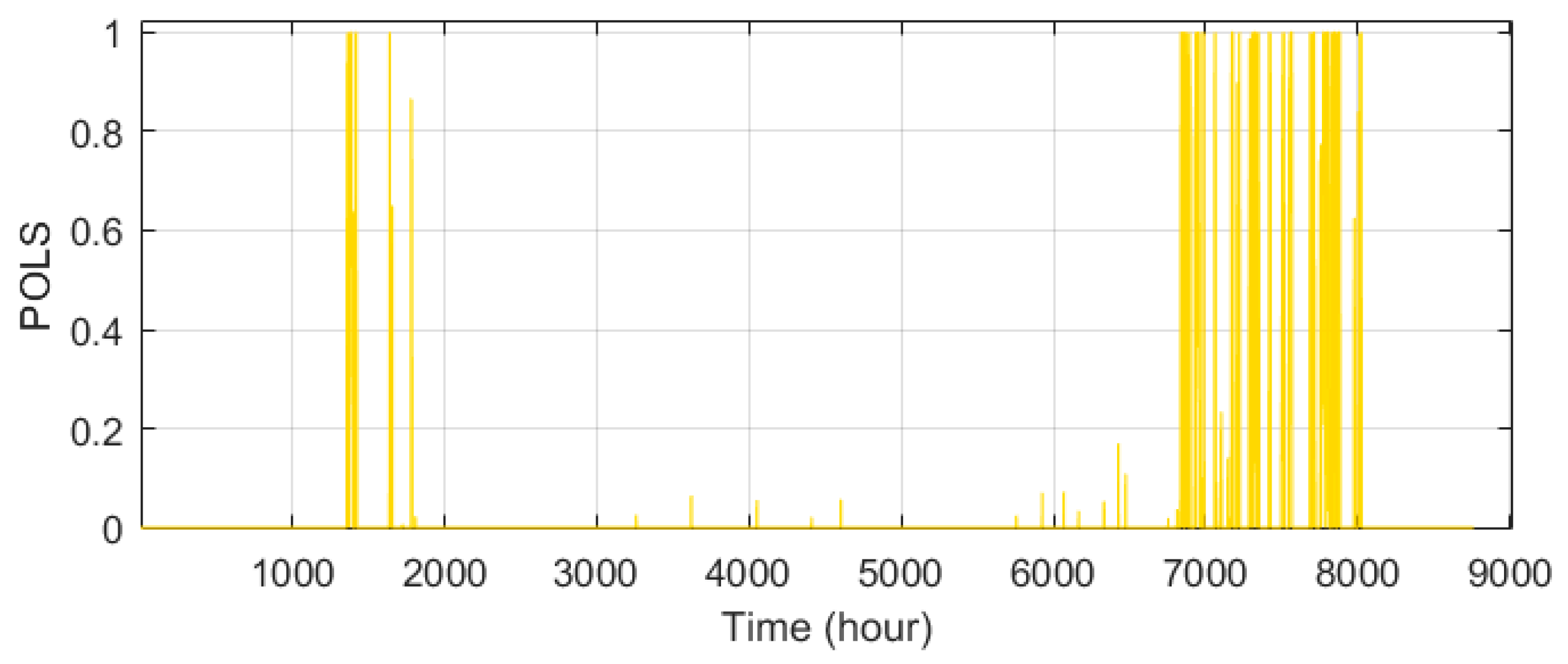
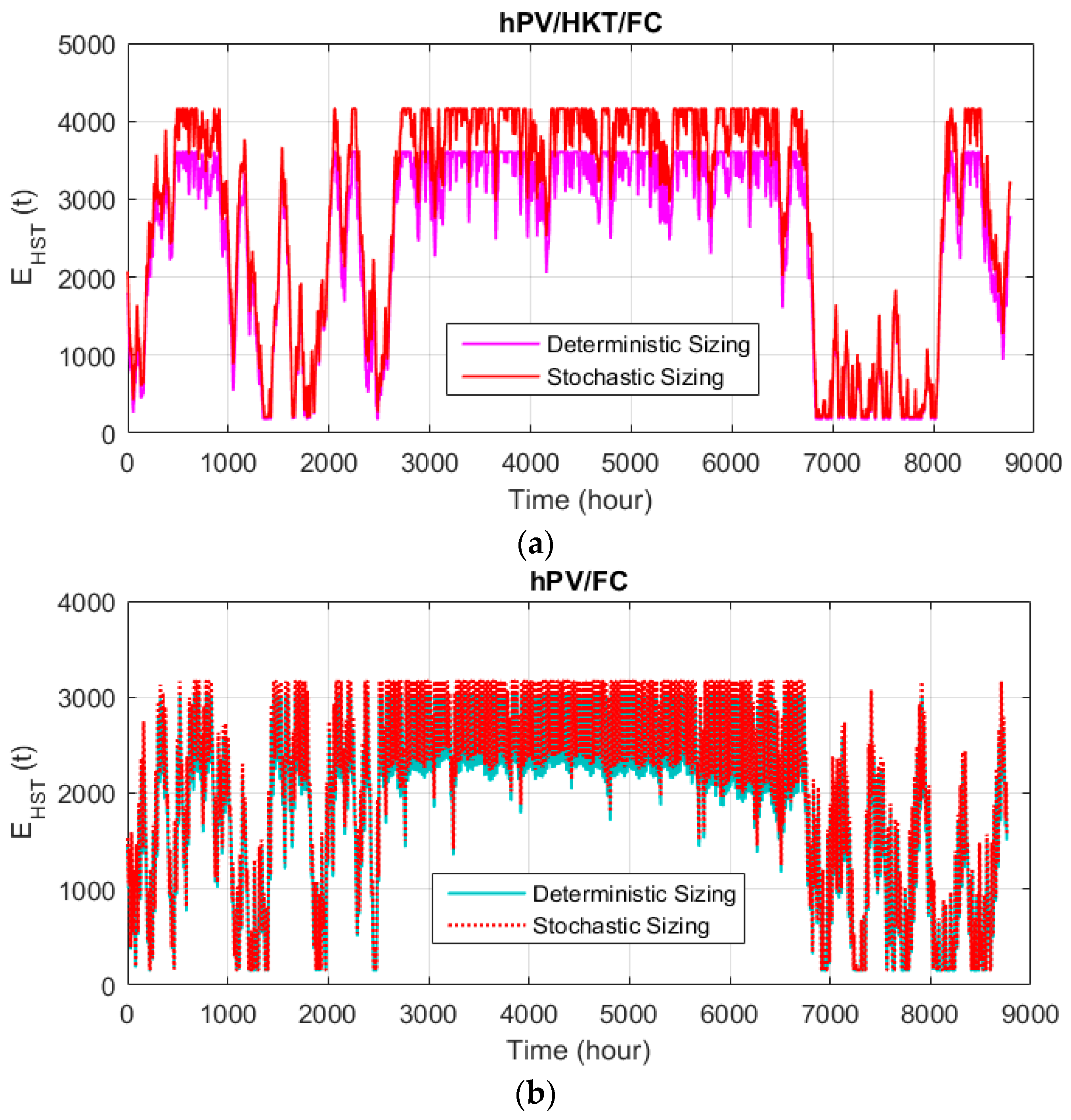
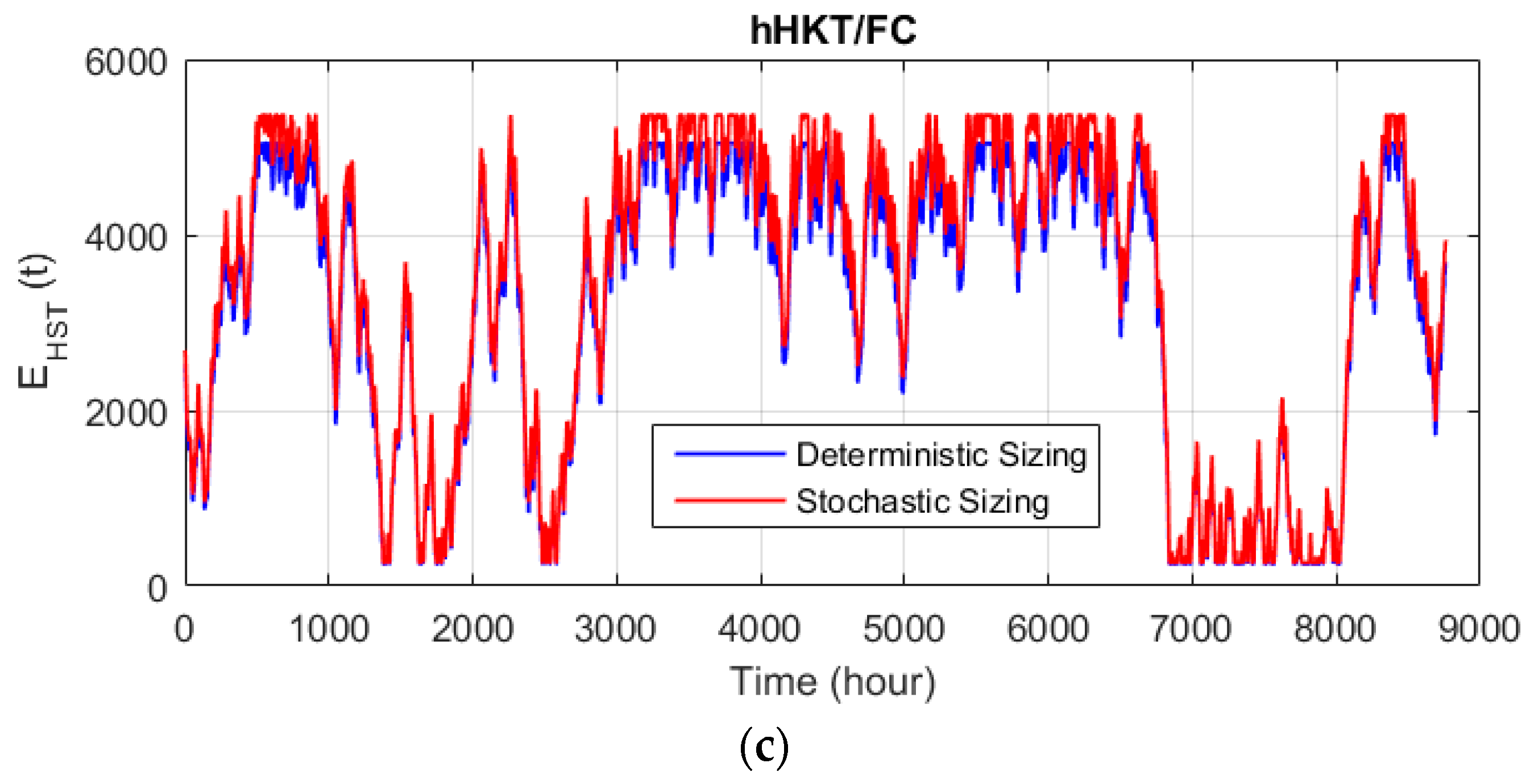
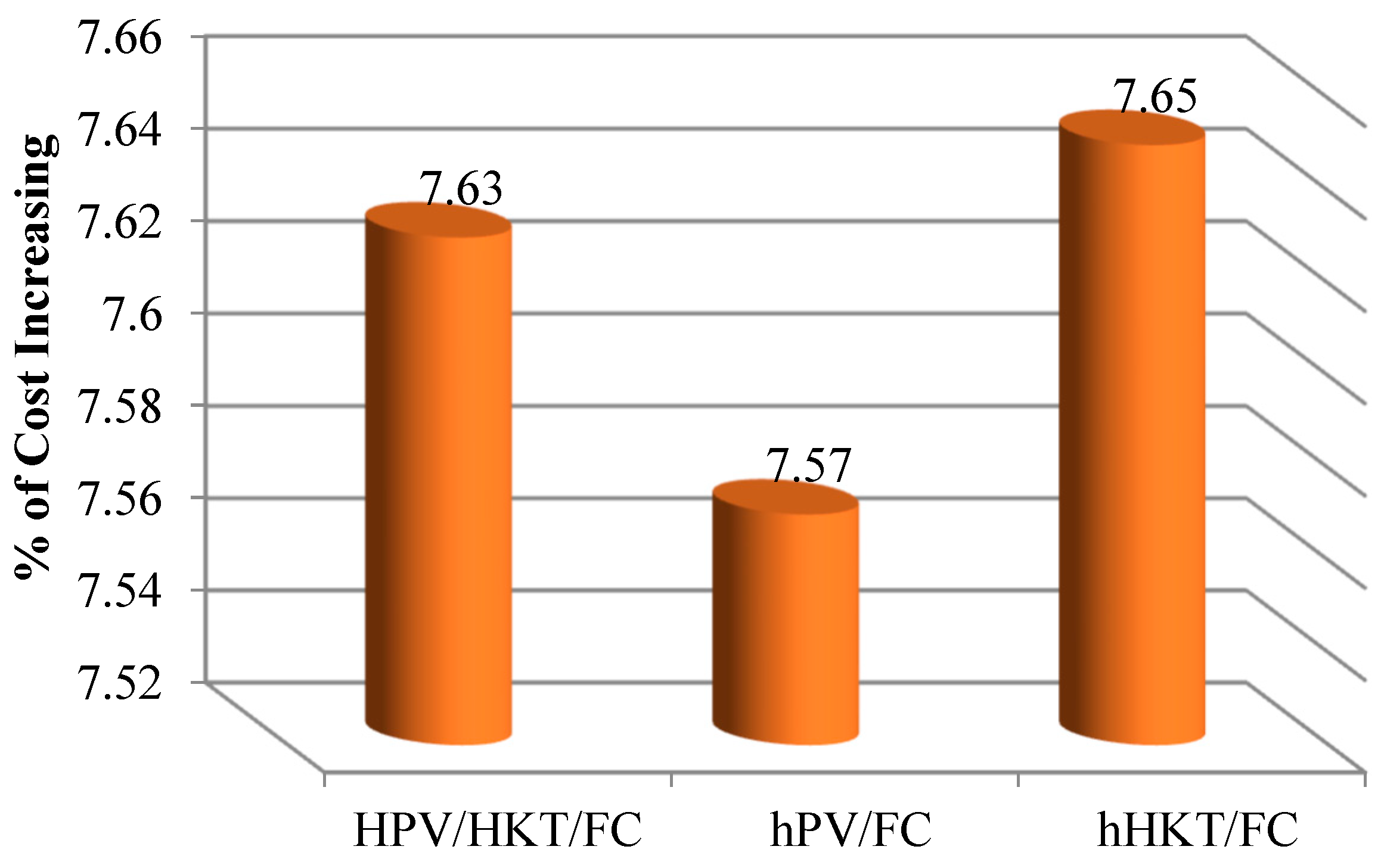

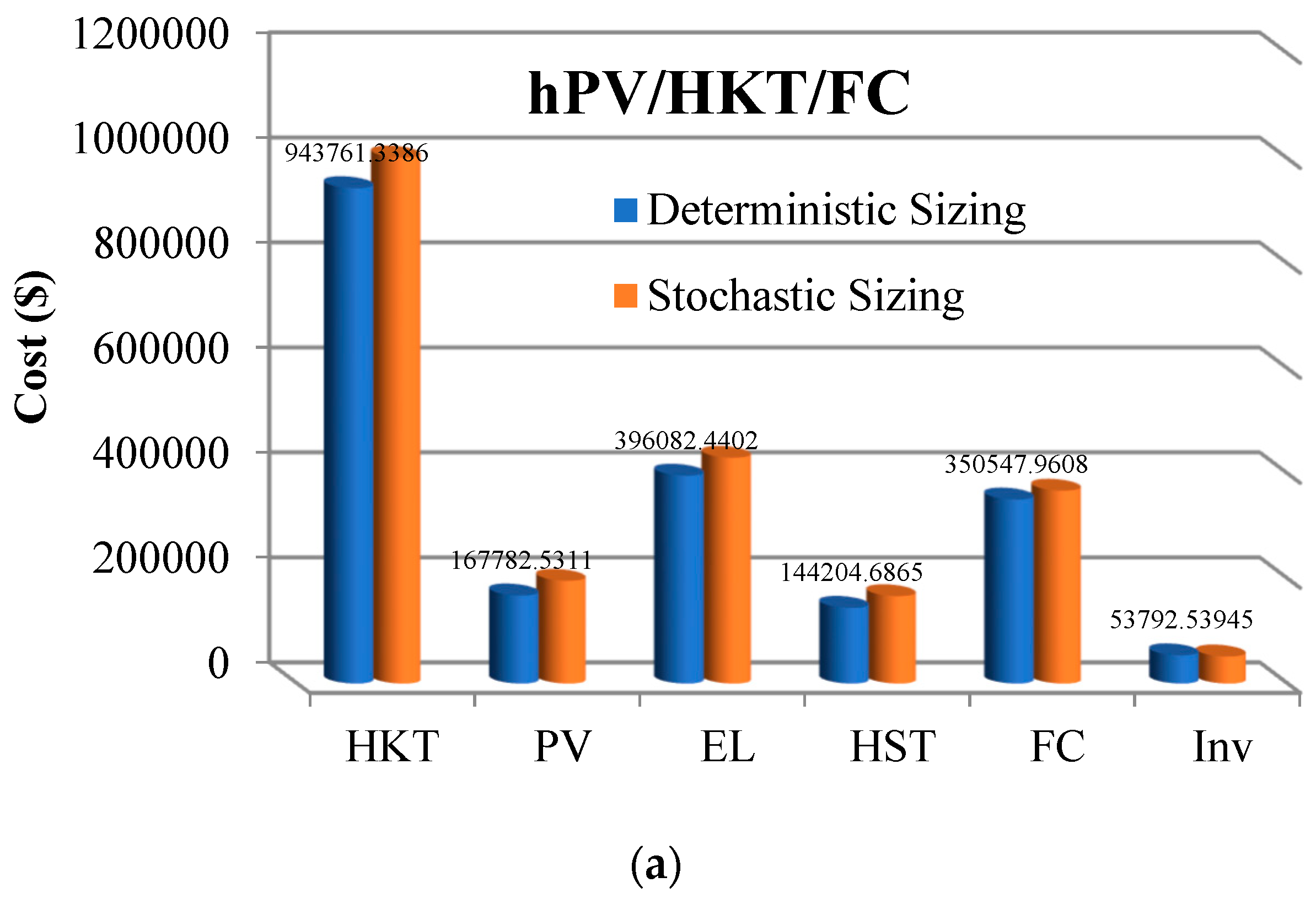

| Ref. | Configuration | HKT | Cost | Reliability | Uncertainty | Improved Solver |
|---|---|---|---|---|---|---|
| [22] | PV + WT + Biowaste | No | Yes | Yes | No | No |
| [23] | FC + Battery | No | Yes | No | No | No |
| [24] | PV + Battery + Diesel | No | Yes | Yes | No | No |
| [25] | PV + FC | No | Yes | Yes | No | No |
| [26] | PV + WT + Battery | No | Yes | Yes | No | No |
| [27] | PV + WT + Battery | No | Yes | Yes | No | No |
| [28] | WT | No | No | No | Yes | Yes |
| [29] | PV + WT + Battery | No | Yes | Yes | No | Yes |
| [30] | PV | No | No | No | Yes | No |
| [31] | PV + WT + Fuel cell | No | Yes | Yes | No | No |
| [32] | PV + WT + Battery | No | Yes | Yes | No | No |
| [33] | PV + Fuel cell | No | Yes | Yes | No | No |
| [34] | PV + Battery | No | Yes | Yes | No | No |
| [35] | PV + WT + Battery | No | Yes | Yes | No | No |
| [36] | PV + Fuel cell | No | Yes | Yes | No | No |
| [37] | PV + WT + Battery | No | Yes | Yes | No | No |
| [38] | PV + WT + Biowaste | No | Yes | No | No | No |
| [39] | PV + Fuel cell + Diesel | No | Yes | Yes | No | No |
| [40] | PV + Battery | No | Yes | No | No | No |
| [41] | PV + WT + FC | No | Yes | Yes | No | Yes |
| [42] | PV + WT + HKT | Yes | Yes | Yes | No | No |
| This paper | PV + WT + HKT | Yes | Yes | Yes | Yes | Yes |
| Device | ($/Unit) | ($/Unit) | ($/Unit-Year) | Rated Size | Efficiency | Life Span (Year) |
|---|---|---|---|---|---|---|
| PV | 2000 | 500 | 33 | 1 kW | - | 20 |
| HKT | 25,000 | 17,000 | 100 | 10 kW | - | 20 |
| EL | 20,000 | 1400 | 100 | 3 kW | 0.74 | 5 |
| HST | 1300 | 200 | 25 | 1 kg | 0.95 | 20 |
| FC | 20,000 | 1400 | 100 | 3 kW | 0.50 | 5 |
| Inv | 800 | 200 | 8 | 1 kW | 0.90 | 15 |
| System Type/Item | |||||||
| hPV/HKT/FC | 360.09 | 70.54 | 37.52 | 16.81 | 90.82 | 14.87 | 55.29 |
| hPV/FC | -- | 1067.57 | 32.83 | 78.14 | 75.93 | 16.91 | 54.16 |
| hHKT/FC | 410.78 | -- | -- | 16.79 | 127.09 | 16.47 | 54.42 |
| System Type/Item | |||||
| hPV/HKT/FC | 0.0339 | 2.056 | 2.058 | 2.061 | 1174.69 |
| hPV/FC | 0.0401 | 4.952 | 4.961 | 4.981 | 5234.29 |
| hHKT/FC | 0.0370 | 2.131 | 2.132 | 2.137 | 700.05 |
| System Type/Item | |||||||
| IGBO | 360.09 | 70.54 | 37.52 | 16.81 | 90.82 | 14.87 | 55.29 |
| GBO | 420.85 | 32.54 | 33.95 | 16.20 | 118.47 | 16.75 | 54.80 |
| PSO | 410.88 | 24.66 | 30.67 | 16.74 | 123.70 | 15.86 | 55.10 |
| AEFA | 350.49 | 85.68 | 38.99 | 16.27 | 143.56 | 14.88 | 55.04 |
| System Type/Item | |||||
| IGBO | 0.0339 | 2.056 | 2.058 | 2.061 | 374.69 |
| GBO | 0.0375 | 2.376 | 2.381 | 2.389 | 1265.55 |
| PSO | 0.0355 | 2.132 | 2.133 | 2.135 | 417.65 |
| AEFA | 0.0394 | 2.152 | 2.157 | 2.161 | 1064.49 |
| System Type/Item | |||||||
| hPV/HKT/FC | 380.32 | 82.25 | 39.46 | 18.25 | 104.79 | 15.59 | 55.76 |
| hPV/FC | -- | 1179.09 | 36.11 | 82.09 | 79.74 | 17.38 | 54.69 |
| hHKT/FC | 460.31 | -- | -- | 17.57 | 135.15 | 17.12 | 54.86 |
| System Type/Item | |||||
| hPV/HKT/FC | 0.0322 | 2.213 | 2.214 | 2.218 | 965.44 |
| hPV/FC | 0.0383 | 5.327 | 5.332 | 5.349 | 3203.55 |
| hHKT/FC | 0.0353 | 2.294 | 2296 | 2298 | 777.06 |
| System/Item | Approach | |||||||||
| hPV/HKT/FC | Deterministic | 36.09 | 70.54 | 37.52 | 16.81 | 90.82 | 14.87 | 55.29 | 0.0339 | 2.056 |
| Stochastic | 38.32 | 82.25 | 39.46 | 18.25 | 104.79 | 15.59 | 55.76 | 0.0322 | 2.213 | |
| hPV/FC | Deterministic | -- | 1067.57 | 32.83 | 78.14 | 75.93 | 16.91 | 54.16 | 0.0401 | 4.952 |
| Stochastic | -- | 1179.09 | 36.11 | 82.09 | 79.74 | 17.38 | 54.69 | 0.0383 | 5.327 | |
| hHKT/FC | Deterministic | 41.78 | -- | -- | 16.79 | 127.09 | 16.47 | 54.42 | 0.0370 | 2.131 |
| Stochastic | 46.31 | -- | -- | 17.57 | 135.15 | 17.12 | 54.86 | 0.0353 | 2.294 |
Disclaimer/Publisher’s Note: The statements, opinions and data contained in all publications are solely those of the individual author(s) and contributor(s) and not of MDPI and/or the editor(s). MDPI and/or the editor(s) disclaim responsibility for any injury to people or property resulting from any ideas, methods, instructions or products referred to in the content. |
© 2023 by the authors. Licensee MDPI, Basel, Switzerland. This article is an open access article distributed under the terms and conditions of the Creative Commons Attribution (CC BY) license (https://creativecommons.org/licenses/by/4.0/).
Share and Cite
Kamal, M.; Pecho, R.D.C.; Fakhruldeen, H.F.; Sharif, H.; Mrzljak, V.; Nowdeh, S.A.; Poljak, I. Photovoltaic/Hydrokinetic/Hydrogen Energy System Sizing Considering Uncertainty: A Stochastic Approach Using Two-Point Estimate Method and Improved Gradient-Based Optimizer. Sustainability 2023, 15, 15622. https://doi.org/10.3390/su152115622
Kamal M, Pecho RDC, Fakhruldeen HF, Sharif H, Mrzljak V, Nowdeh SA, Poljak I. Photovoltaic/Hydrokinetic/Hydrogen Energy System Sizing Considering Uncertainty: A Stochastic Approach Using Two-Point Estimate Method and Improved Gradient-Based Optimizer. Sustainability. 2023; 15(21):15622. https://doi.org/10.3390/su152115622
Chicago/Turabian StyleKamal, Mustafa, Renzon Daniel Cosme Pecho, Hassan Falah Fakhruldeen, Hailer Sharif, Vedran Mrzljak, Saber Arabi Nowdeh, and Igor Poljak. 2023. "Photovoltaic/Hydrokinetic/Hydrogen Energy System Sizing Considering Uncertainty: A Stochastic Approach Using Two-Point Estimate Method and Improved Gradient-Based Optimizer" Sustainability 15, no. 21: 15622. https://doi.org/10.3390/su152115622









